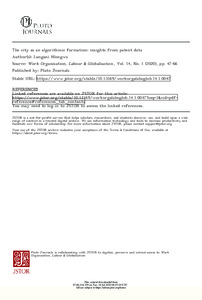The city as an algorithmic formation: insights from patent data

Work Organisation, Labour and Globalisation
2020
14
1
47-66
digital economy ; crowd work ; urban area ; technology ; artificial intelligence
Employment
https://www.scienceopen.com/journal-issue?id=43749fcd-1358-46c6-b608-291f48384b83
English
Bibliogr.
"Around the world, the idea of the smart city has captured the imagination of city governments and private industry. Both are thinking of ways to transform the city into a knowable and predictable space. Key to this transformation are algorithms whose work remains mostly invisible from the general public. However, algorithms are powerful entities that shape an ever-larger part of our lives. As a result, a growing body of research is focusing on how algorithms shape labour and general socio-economic life in the city. There is, therefore, a need to think more critically about how to research algorithms and the work they perform. This article makes use of patent data to show how algorithms shape urban citizenship and labour. Patent data are commonly used in business and technology environments to perform tasks such as innovation assessment, competitor analysis and tracking technological development. In this article, patent analysis is employed to address two interrelated objectives: to show the key players producing the algorithmically regimented city; and to investigate the key technologies they are working on and the evolutionary potential of these technologies. The aim of this article is twofold: first, to contribute to the various methods and perspectives for studying algorithms; second, to examine how patents and patenting facilitate the algorithmic governance of the city."
Digital
The ETUI is co-funded by the European Union. Views and opinions expressed are however those of the author(s) only and do not necessarily reflect those of the European Union or the ETUI.